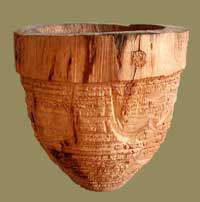|
|
|
|
 |
|
|||||
|
I began the
Ascending Bowl Series in 1979. Ascending Bowl #4, 1981 has
particularly unusual aspects about it that speak to the idea of
serendipity or "happy accident" that the Zen potters talk about.
While roughing out the blank with the chainsaw, I inadvertently uncovered
an irregularity within the wood that suddenly reminded me of a Japanese
seal or chop mark (the identification mark used by the Japanese to signify
ownership by means of a formal insignia). I was taken by the pattern
and left it on the rim of the bowl, working around it to be sure not to
harm it. These kinds of happy accidents occurred occasionally, but
they became part of the work only by being a conscious observer, else the
moment would be lost. |
|||||||
|
Whenever I go to a museum, I wonder why people look at the vessels of ancient civilizations that have been carefully preserved and presented in glass cases. I’ve watched the bowls, I’ve studied them for many years. But now I look at the people who watch the bowls. These bowls were made by ordinary people, who, in those civilizations, were artisans and craftsmen. The creation and use of the vessel was a vital and meaningful part of society. People relied upon vessels for their existence, but not merely as a means to an end; they invested their making and use of the vessel with ceremony, as an integral art of their lives. Now our vessels mean very little to us as a society. We take them for granted, useful adjuncts to our lives, having little meaning. They are usually mass-produced, and made of a nondescript impersonal material. Our interest now is in seeking meaning from the earlier works, the ancient vessel. The obsolete vessel that lies precious behind impenetrable barriers fascinates us. I am intrigued by this fascination. What is it that creates a need, a yearning, to search, to look at and explore these objects? What are we trying to find? And what about the objects? They transcend their function. What secrets do they hold? It is as though they have come hurtling through time and space to fill a void created by our depersonalized, unceremonious lifestyles. To arrive at the point of the Ascending Bowl—which for me was extremely difficult—I had to turn my back on what was traditionally expected of a woodturner and face the apparent surrounding darkness. Somehow I managed to turn what was wrong into what is right. So many years ago, the craftsman I apprenticed with told me, “A true craftsman is the one who can make good his mistakes.” That’s all I remember from him – I’ve been thinking about that for over twelve years. Ascending Bowl is, now, a series of controlled “mistakes”—mistakes made, naturally, before I knew what was “right”, before I was shown the “right” way of doing things. These thoughts influence the work I do in vessel making. The forms I create are not functional, although they have a heritage of utility. The objects, being containers, are inherently functional and could be used. However, as the museum pieces would quickly be destroyed by use because of their age, my vessels would also be ruined by use because of the delicate and precious materials from which they are made. In reality, my bowls are made for people to see, to study, to confront. They serve as the ancient vessels in cases do—they are mass and energy from another place, they offer problems and solutions, questions and answers. They have begun the transition from utility to iconography. |
|||||||
|
|
|||||||
PURCHASING INFO | HOME
| GALLERY
DIRECTORY |
E-MAIL US |
BACK TO VESSELS